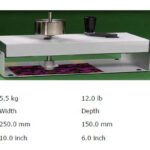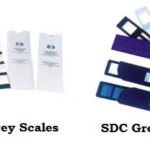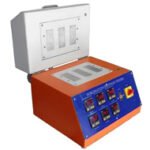Colour Fastness Testing
We can define colourfastness as, having colour that will not run or fade with washing or wear. That means characterizes a material’s colour’s resistance to fading or running. Clothing is colourfast if its colours and dyes do not bleed or run from the clothing. Clothing should be tested for colourfastness before using any type of bleach or bleaching solution, or strong cleaning product. Colourfastness is very important factor for buyer. Colourfastness properties of textiles are an important measure of quality of a product.
Colour Fastness Testing on Fabrics can be done by 5 methods. They are
1. Colour Fastness due to rubbing
2. Colour Fastness due to washing / Dry-cleaning
3. Colour Fastness due to Perspiration and Sea Water
4. Colour Fastness due to sunlight
5. Colour Fastness due to hot pressing and Dry Heat
1. Testing colour Fastness due to Rubbing:
We use the following 3 instruments:
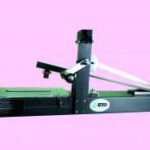
i. Manual Crockmeter:
Colour Fastness testing done by Dry Rub and Wet Rub tests. This tests are used for the determination of colour fastness against rubbing, either under dry or under wet conditions. In this test and moving brass finger of specified shape and size rubs against the test specimens under test and the amount of colour transferred to a piece of abradant fabric fixed over the base of the moving finger are graded with the help of standard grey scales to evaluate the colour fastness against rubbing.
TECHNICAL DETAILS
Technical Specification of Manual Crock Meter
| Rubbing Finger diameter | Ø 16 mm +/-0.2 with white cotton fixing ring |
| Force on the rubbing finger | 9 N ±0.2 N (917.43 gms) |
| Center to center Traverse of the Finger | 104 ± 3 mm |
| Counter | 0 – 9999, (Least Count : 1) |
| Dimension | 640 (L) X 95 (W) X 195 (H) mm |
| Over all Weight | 6.5 kg |
| Size of crock square | (5 x 5) Cms. |
ii. Digital Crockmeter:
Colour Fastness testing done by Dry Rub and Wet Rub tests. This tests are used for the determination of colour fastness against rubbing, either under dry or under wet conditions. In this test and moving brass finger of specified shape and size rubs against the test specimens under test and the amount of colour transferred to a piece of abradant fabric fixed over the base of the moving finger are graded with the help of standard grey scales to evaluate the colour fastness against rubbing.
TECHNICAL DETAILS
| Electrical Supply Consumption | : 200-240 AC @ 50 Hz : 250 Watts Max. |
| Environmental Temperature Altitude | : 20 – 50oC : 1000 meters above MSL |
| Technical Dia of the Finger Length of the Traverse of the finger Effective Load on the finger Size of Test specimen (fabric) Size of Crocking cloth Overall dimension of the unit | : 16 mm. : 104 ± 3mm. : 9N ± 10 %. : 300mm X 150 mm. : 5cm X 5cm. : 13” x 29” x 13” (Inches). |
iii. Rotary Crockmeter
Colour Fastness testing done by Dry Rub and Wet Rub tests. This tests are used for the determination of colour fastness against rubbing, either under dry or under wet conditions. Rotary Crockmeters are used for testing printed fabrics. this test and moving brass finger of specified shape and size rubs against the test specimens under test and the amount of colour transferred to a piece of abradant fabric fixed over the base of the moving finger are graded with the help of standard grey scales to evaluate the colour fastness against rubbing.
For Grading, Greyscales are used:
2. Testing Colour Fastness due to washing / Dry-cleaning:
Digital Washing Fastness Tester:
Digital Washing Fastness Tester is used to determine the colour fastness of any type of dyed and printed textile material against washing. There are 3 models:
– ISO METHOD
– AATCC METHOD
– ISO/AATCC METHOD IN ONE
Technical Specifications: Power Supply: 220 V, Single Phase
Motor RPM: 40
Motor: ½ HP, Geared Motor
Timer & Temperature Control: Digital
Max Temperature: 99◦ C
Temperature Accuracy: 0.1◦ C
Max Timer: 999
Beakers:
| For ISO | : 8 beakers of 550 mL |
| For AATCC | : 8 beakers of 1100 mL |
| For ISO & AATCC in one | : 4 beakers of 550 mL & 4 beakers of 1100 mL |
For Testing Colour Change Greyscales are used:
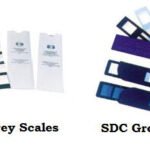
3. Colour Fastness due to Perspiration and Sea Water
Perspirometer: Perspiration Tester for testing the colour fastness of textiles due to perspiration and yellowing. There are 2 types of Perspirometer:
ISO METHOD
AATCC METHOD
Perspiration test chemicals supplied along with instrument.
– For AATCC 3.63 kg dead weight or for ISO 4.13 kg dead weight is provided.
– 2 plates of total 910 grams is provided for loading.
– Sodium chloride GR , Sodium di hydrogen ortho phosphate,sodium hydroxide flakes,di sodium hydrogen ortho phosphate,L-histidiene besides beakers/blotting paper/standard adjacent fabric supplied.
– Net weight :8.3 kg
– Net dimension :10”×3.5”×7.5”.
– 21 acrylic plates for sample holder is also provided each of 115mm*60mm*1.5mm thickness.(Option available to supply perspiration kit which contains all chemicals 7 accessories to conduct perspiration tests against ISO/AATCC standards).
4. Colour Fastness due to sunlight
MBTL Light Fastness tester:MBTL Light Fastness Tester is used to determine the Colour Fastness and degradation due to the effects of sunlight on Textiles.
Technical Details :
– Light Source :500W, MBTL Fading Lamp (Mercury Blinded Tungsten Lamp)
– Test Chamber Temperature:Ambient to 50OC
– Temperature Range Control:By Water Circulation in Type ‘A’ Rectangular Cells
– Type ‘A’ Rectangular Cells:03 Nos. supplied
– Maximum Number of Tupe:50 Nos.
– C’ Cylindrical Cells
– Specimen Thickness :Up to 15mm
– Specimen Size:100 X 50mm
– Maximum Number of Specimen:10 Nos.
– In the ‘A’ Rectangular Cells
– Working Life of Lamps:2000Hours
– Power:220Volts
– Power Consumption:Maximum 1KW
For Grading:
5. Colour Fastness due to hot pressing and Dry Heat:
Sublimation Tester:
Sublimation Fastness tester is a suitable instruments for dyestuff manufacturer as well as textile processor for checking effects of dry heat on dyestuff Sublimation and staining effect properties of individual dyes can be tested at various temperatures. In a single test, entire range of effective temperature can be tested. The heating pads are made up of Aluminium for even and quick distribution of heat. TECHNICAL
TECHNICAL DETAILS
| No. of Heating Pads | : 06 Nos |
| No. of Heating Stations | : 03 Nos |
| Temperature Range | : Up to 2100C |
| Power Read-out | : Digital Display for Each Pad |
| Timer Range | : 10 to 60 Seconds |
| Size of Each Pad | : 100 mm x 40 mm |
| Machine Dimension | : 400 mm x 350 mm x 280 mm |
| Net Weight | : 19 Kg |
| Supply Voltage | : 220 V AC |


